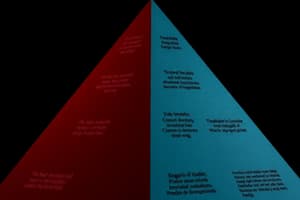Podcast
Questions and Answers
How does pacing primarily affect the narrative?
How does pacing primarily affect the narrative?
- It speeds up or slows down the events of the story. (correct)
- It creates recurring images or symbols within the story.
- It reveals the underlying theme of the story.
- It establishes the emotional tone of the story.
Which element of Freytag's Pyramid introduces the main characters and setting?
Which element of Freytag's Pyramid introduces the main characters and setting?
- Rising action
- Exposition (correct)
- Falling action
- Inciting incident
In the context of poetry, what is a volta?
In the context of poetry, what is a volta?
- A 14-line poem written in iambic pentameter.
- The repetition of initial consonant sounds in neighboring words.
- A shift in emotion or feeling within the poem. (correct)
- A pause within a line of poetry.
Which of the following best describes 'motif' in literature?
Which of the following best describes 'motif' in literature?
Which of the following defines 'affordance of forms'?
Which of the following defines 'affordance of forms'?
What is the unrhymed verse that utilizes iambs called?
What is the unrhymed verse that utilizes iambs called?
What is the primary characteristic of a lyric poem?
What is the primary characteristic of a lyric poem?
Which of the following rhyme schemes is characteristic of a Shakespearean sonnet?
Which of the following rhyme schemes is characteristic of a Shakespearean sonnet?
How does 'internal rhyme' differ from 'end rhyme'?
How does 'internal rhyme' differ from 'end rhyme'?
If a line of poetry concludes with a punctuation mark, what is it called?
If a line of poetry concludes with a punctuation mark, what is it called?
What is the literary device that uses 'like' or 'as' to compare two things?
What is the literary device that uses 'like' or 'as' to compare two things?
Which literary device involves giving human characteristics to inanimate objects or abstract concepts?
Which literary device involves giving human characteristics to inanimate objects or abstract concepts?
What is the figure of speech in which a part is used to represent the whole, or vice versa?
What is the figure of speech in which a part is used to represent the whole, or vice versa?
What is the literary device that makes a reference to a well-known person, event, or literary work?
What is the literary device that makes a reference to a well-known person, event, or literary work?
What is the term for the repetition of vowel sounds in nearby words?
What is the term for the repetition of vowel sounds in nearby words?
Which of the following describes cacophony in literature?
Which of the following describes cacophony in literature?
What is the term for when a phrase continues beyond the end of a line?
What is the term for when a phrase continues beyond the end of a line?
What does 'connotation' refer to?
What does 'connotation' refer to?
What is the external structure of a work?
What is the external structure of a work?
Which of the following describes a 'slant rhyme'?
Which of the following describes a 'slant rhyme'?
Flashcards
Atmosphere
Atmosphere
The emotional tone or ambiance of a scene or story.
Setting
Setting
The time, place, and conditions in which the story takes place.
Motif
Motif
A recurring image, object, or event that develops a symbolic meaning.
Theme
Theme
Signup and view all the flashcards
Genre
Genre
Signup and view all the flashcards
Plot
Plot
Signup and view all the flashcards
Sci-Fi
Sci-Fi
Signup and view all the flashcards
Lyric
Lyric
Signup and view all the flashcards
Blank verse
Blank verse
Signup and view all the flashcards
Rhyme Scheme
Rhyme Scheme
Signup and view all the flashcards
End Rhyme
End Rhyme
Signup and view all the flashcards
Internal Rhyme
Internal Rhyme
Signup and view all the flashcards
Sonnet
Sonnet
Signup and view all the flashcards
Volta
Volta
Signup and view all the flashcards
Alliteration
Alliteration
Signup and view all the flashcards
Assonance
Assonance
Signup and view all the flashcards
Enjambment
Enjambment
Signup and view all the flashcards
Caesura
Caesura
Signup and view all the flashcards
Connotation
Connotation
Signup and view all the flashcards
Simile
Simile
Signup and view all the flashcards
Study Notes
- Atmosphere is the emotional tone or ambiance of a story.
- Setting refers to where and when a story takes place.
- A motif is a recurring image, object, or event in a narrative.
- Theme represents the central idea or concept explored in a story.
- Affordance of forms describes potential actions in materials and designs.
- Prose is a type of short story.
- Sequencing involves the order in which events are presented.
- Pacing determines the speed at which events unfold.
- Genre signifies a specific type of literature, like science fiction.
- Plot constitutes a series of events that make up a story.
Freytag's Period
- Exposition introduces the setting, characters, and initial situation.
- Inciting incident sets the conflict in motion.
- Rising action builds tension and develops the conflict.
- Climax is the turning point or moment of highest tension.
- Falling action leads towards the resolution of the conflict.
- Resolution/Denouement provides the outcome or conclusion of the story.
- Science fiction imagines a reality using science to enhance understanding.
- Lyric poetry uses the first-person point of view and often includes reflection.
- The poet's persona is often, but not always, reflected in lyric poetry.
- Iambic pentameter consists of iambs (an unstressed syllable followed by a stressed syllable), with five of these feet per line.
- Blank verse is unrhymed and uses iambs with other poetic devices.
- Internal structure refers to the content of the poem.
- External structure relates to the form of the poem.
- Rhyme scheme follows a pattern at the end of the line, creating a letter-based scheme.
- End rhyme occurs at the final line of poetry.
- Internal rhyme features rhyming words within the middle of a line.
- Perfect rhyme involves words that rhyme exactly, like "bye," "hi," and "sigh."
- Slant/imperfect rhyme uses similar but not identical vowel sounds.
- Eye rhyme has words that look like they rhyme but do not sound alike.
- Feminine rhyme ends on a falling note, represented by /
- Masculine rhyme ends on a rising note, represented by U
Sonnets
- Sonnets consist of 14 lines in iambic pentameter, which is five stressed and unstressed syllables a line.
- Petrarchan sonnets follow an ABBA ABBA CDE CDE rhyme scheme.
- Shakespearean sonnets follow an ABAB CDCD EFEF GG rhyme scheme.
- Spenserian sonnets use an ABAB BCBC CDCD EE rhyme scheme.
- Volta represents a shift in emotion, feeling or a turning point in a poem.
- Accentual verse focuses on stresses and the total number of syllables.
- Sestina includes a six-line stanza.
- In a Sestina, the first word of every line is repeated in a set, becoming the end word from the prior line.
- Villinale uses the repeating rhyme scheme ABA ABA ABA ABA ABA ABAA.
- All ordnance of forms include Sestina and Villinale.
- Alliteration utilizes emphasis through repetition.
- Assonance shows the repetition of vowel sounds.
- Consonance features repetition of two or more sounds with an intervening vowel change.
- Euphony uses a series of words that sound smooth or musical.
- Cacophony describes language that sounds harsh, rough, and unpleasant.
- Enjambment occurs when a phrase carries on beyond the line break.
- End-stopped lines end with a punctuation mark at the end of the line.
- Caesura represents a pause within a line of poetry.
- Ambiguity shows multiple meanings.
- Connotation is not literal meaning.
- Denotation is the literal meaning.
- Figurative language includes similes.
- Similes makes a comparison of different things using 'like' or 'as'.
- Metaphors describe one thing as if it were another.
- Both similes and metaphors describe one thing as another.
- Personification attributes personal qualities to non-human objects.
- Metonymy uses associated things that are not the same thing.
- Synecdoche uses a part of something to represent the whole.
- Imagery is the vivid descriptions.
- Allusion is references.
- Significant associations are established using imagery.
Scanning Poems
- Look for multi-syllable words.
- Identify stressed versus unstressed syllables.
- Articles and prepositions are typically unstressed.
- Determine the rhyme scheme.
- Identify the content using internal structure
- Note the form using external structure
Studying That Suits You
Use AI to generate personalized quizzes and flashcards to suit your learning preferences.




